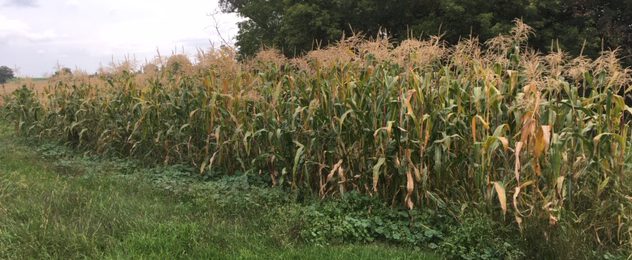Why this subject? Well, my life journey does include a decade as a dairy farmer so growing stuff is not just a hobby. And, I find that a lot of people do not know of this technique. Lastly, if you don’t keep the raccoons at bay, you can grow sweetcorn but you will never get to eat much of it.
Here is this years sweet corn. About 80 feet of 4 x 38″ rows. It yielded us nearly 400 ears that we processed for future use or ‘donated’ to siblings, neighbors etc.

This picture looks innocuous enough so why am I showing it to you? This is about 3 weeks post-harvest. The thing to note is the stalks are all still standing up! That matters because if we hadn’t done something to stop the local raccoons, it would all be on the ground and our yield would have been closer to 4 ears than 400.
Raccoons can smell sweet corn. I have hidden a few rows in the middle of a 20 acre field of field corn on a 200 acre farm full of field corn. About a week before it’s ready to harvest, I would find it all knocked down and eaten with the field corn around it untouched. It looked like an alien ship landed and flattened everything. Then I discovered the method that has worked for us for the past 20 plus years.
Folklore has lots of methods to keep the raccoons out. Things that smell such as hair or soap. Co-planted crops like squash, cucumbers etc. IME, none of these do anything but slow down the raccoons. They will not stop them.
A method that does work is electric fencing. The problem here is what can go wrong. Grasses and other plants can short it out especially if it rains. Deer, another sweet corn enemy, can knock it down leaving an opening. If any of this happens within a week or so of harvest, the raccoons will ravage the crop.
There is one last method that does work. Grow so much sweet corn that the raccoons cannot eat it all! For a home plot, this is just not practical.
The method we use is also mentioned here and there but not with the specifics we have found important. We use a radio. Done correctly this has never let us down.
Here are the rules:
Protect the radio from the weather. We use a large plastic\rubber waste basket. We place it in the center of the corn. Prop one end with a rock or piece of wood so that any water that gets inside will run out.

Place the radio into the container as far as you can reach. Here you see ours tucked into the container.

Provide uninterrupted power. We use an extension cord. This means you need to plant within say 300 feet of a power outlet but that has another benefit I will mention later. Hint, if the extension cord crosses anything you cut with a mechanical device, i.e a lawn mower, some carefully placed flags will prevent inadvertently mowing away your power.
Here is where we vary from the folklore that is out there. Raccoons are very wary of people. They seem to recognize, and do not like, the sound of a human voice. So, playing loud music etc. is not the magic answer. Find the strongest 24 hour talk radio station in your locale. Look at the internet to insure that is is 24 hour talk, not music from 1 AM to 4 AM and talk during the day. As an alternative, sports broadcasts can work as well as talk. The commentators are talking so it’s cool.
Test to insure that it works at night. Some stations, especially AM, will drift at night due to atmospheric caused interference. Some stations drop their power at night. We put a radio on the patio on the same station to verify reception BEFORE we need it in the corn.
Make sure its loud enough. You have it 2-3 feet into a container. We can hear the radio from 300 feet away albeit faint. It’s a bit spooky but we like sweet corn so who cares.
Start the radio right after the corn tassels. For most varieties, it’s 3 weeks from tassel to picking. As soon as the ears blister, it begins to attract racoons so don’t wait too long.
For us, this has worked great. We have never needed to relocate the radio. In fact, I have a radio on 24 hour talk in my shop 24 x 365 and it keeps the racoons out of there all year. We also use it in our chicken house. Racoons love to kill and eat chickens!
As I mentioned there is one additional advantage to having the patch within 300 feet of your home. Deer also like sweet corn. They are not as aggressive but will nibble on ears at the edge of a patch. They do not knock the corn down. They generally won’t go into the patch but they cause loss nevertheless. The radio does not stop them but the closer the corn is to our home, the less they are an issue.
I am posting this at absolutely the wrong time of year for the northern hemisphere but given time for search engine indexing, hopefully it helps some of you in 2021. In the meantime, I should point out that the radio technique works for racoons all year.
-Nick